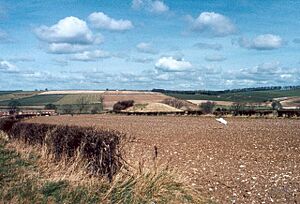Duggleby Howe facts for kids
Duggleby Howe is one of the biggest round barrows (ancient burial mounds) in Britain. It is also called Howe Hill. You can find it on the south side of the Great Wold Valley in Ryedale. It is one of four similar large mounds in this area. These are known as the Great barrows of East Yorkshire.
Experts believe Duggleby Howe was built in the Late Neolithic period. This is based on items found there. The Neolithic period was a time when people started farming. The word "Howe" likely comes from an old Norse word, haugr, which means "mound" or "hill."
The mound itself was once about 37 meters (120 feet) wide at its base. The top of the mound seems to have been flattened a long time ago. This left a flat area about 14 meters (47 feet) wide. A post-mill (a type of windmill) was built on this flat top during the Middle Ages. The mound was about 7 meters (22 feet) tall on its east side. It was about 5 or 6 meters (18 or 19 feet) tall on its west side.
Duggleby Howe sits inside a large, nearly round area. This area is about 370 meters (1,214 feet) wide. It is marked by ditches that are not continuous. The area is open to the south. To the east of the mound, there are two ring ditches. One is inside the main area, and one is outside. These are thought to be from the Bronze Age. People knew about the mound for a long time. But it was not until 1979 that its large outer area was confirmed. This happened using aerial photos taken by D. N. Riley.
The mound was first dug into in 1798 or 1799 by Reverend Christopher Sykes. Sadly, no records of his work remain. Later, starting on July 21, 1890, J. R. Mortimer led another dig. He was sponsored by Sir Tatton Sykes. Mortimer dug a 40-foot square area over the center of the mound. He also dug part of the east side. This work lasted more than six weeks. In 1983, experts re-examined Mortimer's findings. They used this information to understand the mound's history.
Contents
How Duggleby Howe Was Used Over Time
Phase I: The First Burials
The first activity at Duggleby Howe involved digging a deep shaft. At the bottom of this shaft, an adult male was buried. He was placed in a crouched position. Next to him were a special pot called a Towthorpe bowl, and some flint tools.
Higher up in the shaft, another adult and a baby were buried. They were also in a crouched position. At the feet of the adult, another adult skull was placed. This skull showed signs of injury. Some experts believe this suggests a very rare case of a special ceremony for British Neolithic burial sites.
Phase II: More Burials Added
After the deep shaft was filled in, two more adults were buried. They were placed in the hollow that formed as the soil settled. Flint and antler tools were buried with them.
Phase III: Building the Mound
Next, a shallow grave was dug to the east of the shaft. Another adult was buried here in a crouched position. This person was buried with flint arrowheads, flint flakes, a bone pin, and tools made from boar tusks and beaver teeth.
Then, the main round mound was built. It was made of "clayey or earthy matter." Inside this mound, the remains of four babies, three children, one teenager, and one adult were found. The mound was finished with a layer of small chalk pieces. On top of that was a thin layer of "Blue Kimmeridge clay."
Phase IV: Adding Cremations
After the main mound was built, 53 cremations (burnt remains) were placed on its top. None of the cremated remains were in pots. They were found in piles, about 15-45 centimeters (6-18 inches) wide. They were also about 2-15 centimeters (1-6 inches) high. Mortimer thought there might be many more cremations in the parts of the mound he did not dig. Only three small pieces of burnt bone pins were found with the cremations.
Phase V: Making the Mound Bigger
Later, the mound was made even larger. Workers added "roughly quarried chalk" to create the huge final mound. Much later, the mound was used as the base for a post-mill (a type of windmill).
Experts like Ian Kinnes believe Duggleby Howe was a cemetery used for a very long time. It shows how burials changed during the Late Neolithic period. Roy Loveday and J.R. Mortimer suggested that the many burials might have been part of a special event. Perhaps they marked the death of an important person. This person might have been the individual found at the very bottom of the first shaft grave.
Mortimer's digging methods were good for his time. However, they did not record enough details about the layers of soil and finds. This makes it hard for today's experts to fully answer all questions about the mound.
The Great Barrows of East Yorkshire
- Willy Howe
- South Side Mount
- Wold Newton Barrow 284
- Duggleby Howe


